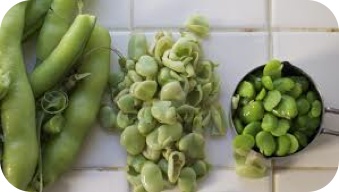News and Notes from The Johnson Center
Fava Beans: A Tasty Palate Pleaser
JCCHD | Mon, July 08, 2013 | [Family and Food]
Fava beans have been an international culinary favorite for centuries and are currently making their way into your local grocery store. The slow integration into American markets could be due to their laborious preparation method; however, many agree fava beans are worth the effort. Their subtle nutty taste and buttery texture have made them the flavor of the month.
How to Select, Peel, and Store
Fava beans are in season throughout the summer, becoming available in May and peaking in July. Look for firm, undamaged (unopened) pods. Immature beans will be smaller and sweeter. Mature beans will be firmer, and their rough cases must be removed. Simple instructions are outlined below.
 How to peel fava beans:
How to peel fava beans:
• Split pod open with your fingers and remove the beans.
• Boil the beans in salt water for 3 minutes then submerge them in ice water to stop the cooking process.
• The outer layer will be soft and can be removed by simply squeezing the bean.
If beans are removed from the outer skin, it is best to eat them immediately. However, you can also freeze them for a month. Fava beans in the pod can be stored in a dry place for up to three days. If you have space, they last up to five days in the refrigerator.
Health Benefits
Fava beans are packed with protein, approximately 13g per cup.[1] Protein consumption is important because we get 20 essential amino acids (units that make up protein) from food. You may remember from science class that amino acids are the building blocks for life (DNA and RNA). Tissues such as muscles, skin, hair, and nails are also composed of amino acids. Other important cells made up of protein are the blood cells that help fight infections.
Fava beans also contain fiber, potassium, iron, and vitamins A and C. This combination of nutrients contributes to a number of health benefits:
• Helps prevent constipation. Fiber regulates your digestive system by moving food particles through the intestines.[2]
• Maintain water balance. Potassium contains electrolytes, which promote proper water and acidity levels in your body. Electrolytes are lost in sweat and need to be constantly replenished.[3]
• Stay oxygenated. Iron is an important component of hemoglobin. Hemoglobin is responsible for transporting oxygen from the lungs to other cells.[4]
• Boost your immune system. Vitamin C is a powerful antioxidant which helps reduce the percentage of cancer-causing free radicals and the level of immune system deficiencies.[5]
Fava beans can replace garbanzo and soybeans in recipes. Here are a few suggestions to get you started in the kitchen.
Fava Bean Hummus
From http://www.wholefoodsmarket.com

Ingredients:
• 2 cups dried fava beans
• 2 tablespoons extra-virgin olive oil
• 2 tablespoons lemon juice
• 1 tablespoon plus 1 teaspoon tahini
• 1 clove garlic
• ½ teaspoon dried oregano
• ½ teaspoon fine sea salt
Directions:
1. Place beans in a large bowl with enough cold water to cover by 2 inches. Let soak overnight.
2. Drain soaked beans. Remove outer shell from each fava bean and discard.
3. Place peeled beans in a large saucepot. Cover by 2 inches with cold water and bring to a boil. Reduce heat, cover and simmer, until beans are very tender, about 30 minutes.
4. Drain beans and place in the bowl of a food processor.
5. Add oil, lemon juice, tahini, garlic, oregano and salt and process until puréed.
Omega-3 Omelet with Spring Greens and Beans
From http://www.huffingtonpost.com

Ingredients:
• 1/4 cup dill
• 1/4 cup fennel
• 1/4 cup flat-leaf parsley
• 1/2 cup spring onions
• 1/2 cup fresh fava beans
• 6 omega-3 egg whites
• 6 omega-3 egg yolks
• 4 zucchini squash, grated
• Sea salt and freshly ground black pepper, to taste
• 1 tablespoon olive oil
• 1/2 cup vegan cottage cheese
Directions:
1. Preheat the broiler. Finely chop the dill, fennel, parsley and spring onions. Blanch the beans.
2. Whisk the egg whites until soft peaks form and then fold in the egg yolks. Set aside some of the chopped herbs, then fold the rest into the egg mixture, along with the grated zucchini. Season to taste.
3. Heat the olive oil in a pan over a medium heat. Pour the mixture into the pan and cook briefly. Place the pan with the egg mixture under a hot broiler until the top turns slightly golden in color.
4. Spoon over the cottage cheese, scatter with the remaining herbs and serve with the beans on the side.
Article resources
1 http://nutritiondata.self.com/facts/legumes-and-legume-products/4322/2
2 http://www.nutritionmd.org/nutrition_tips/nutrition_tips_understand_foods/fiber_benefits.html
3 http://www.nlm.nih.gov/medlineplus/ency/article/002350.htm
4 http://www.webmd.com/vitamins-and-supplements/lifestyle-guide-11/iron-supplements?page=1
5 http://www.webmd.com/diet/features/the-benefits-of-vitamin-c



